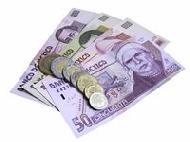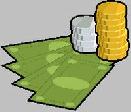
 |
|
| Financial Terms | |
| Product |
|
Information about financial, finance, business, accounting, payroll, inventory, investment, money, inventory control, stock trading, financial advisor, tax advisor, credit.
Main Page: money, financial, accounting, credit, finance, tax advisor, inventory control, inventory, |
Definition of Product
ProductAny item intended for sale.
Related Terms:Gross domestic product (GDP)The market value of goods and services produced over time including the Gross national product (GNP)Measures and economy's total income. It is equal to GDP plus the income Investment product line (IPML)The line of required returns for investment projects as a function of beta Product cycleThe time it takes to bring new and/or improved products to market. Product riskA type of mortgage-pipeline risk that occurs when a lender has an unusual loan in production or Production payment financingA method of nonrecourse asset-based financing in which a specified Production-flow commitmentAn agreement by the loan purchaser to allow the monthly loan quota to be  UNITS OF PRODUCTIONA depreciation method that relates a machine’s depreciation to the number of units it makes each Non-production overheadA general term referring to period costs, such as selling, administration and financial expenses. Product costThe cost of goods or services produced. Product marketA business’s investment in technology, people and materials in order to make, buy and sell products or services to customers. Product/service mixSee sales mix. Production overheadA general term referring to indirect costs. product costThis is a key factor in the profit model of a business. product by-productan incidental output of a joint process; it is salable, cost of production reporta process costing document that  economic production run (EPR)an estimate of the number equivalent units of production (EUP)an approximation of the number of whole units of output that could have been grade (of product or service)the addition or removal of product process productivitythe total units produced during a period product complexityan assessment about the number of components in a product product contribution marginthe difference between selling price and variable cost of goods sold product costa cost associated with making or acquiring inventory productive capacitythe number of total units that could be product- (or process-) level costa cost that is caused by the development, production, or acquisition of specific products or services product life cyclea model depicting the stages through product line marginsee segment margin  product varietythe number of different types of products By-productA product that is an ancillary part of the primary production process, having Joint productA product that has the highest sales value from among a group of products Product costThe total of all costs assigned to a product, typically including direct Production yield varianceThe difference between the actual and budgeted proportions Aggregate Production FunctionAn equation determining aggregate output as a function of aggregate inputs such as labor and capital. Factor of ProductionA resource used to produce a good or service. The main macroeconomic factors of production are capital and labor. Gross Domestic ProductTotal output of final goods and services produced within a country during a year. Gross National ProductTotal output of final goods and services produced by a country's citizens during a year. National Income and Product AccountsThe national accounting system that records economic activity such as GDP and related measures. Net Domestic ProductGDP minus depreciation. Net National ProductGNP minus depreciation. ProductivityOutput per unit of input, usually measured as output per hour of labor. Sales Revenue Revenue recognized from the sales of products as opposed to the provision ofservices. By-productA material created incidental to a production process, which can be Lean productionThe technique of stripping all non-value-added activities from Process flow productionA production configuration in which products are continually AssetsA firm's productive resources. BackwardationA market condition in which futures prices are lower in the distant delivery months than in CarA loose quantity term sometimes used to describe a the amount of a commodity underlying one Cash discountAn incentive offered to purchasers of a firm's product for payment within a specified time Deferred-annuitiesTax-advantaged life insurance product. Deferred annuities offer deferral of taxes with the Dollar durationThe product of modified duration and the initial price. Economic earningsThe real flow of cash that a firm could pay out forever in the absence of any change in Economies of scaleThe decrease in the marginal cost of production as a plant's scale of operations increases. EnhancementAn innovation that has a positive impact on one or more of a firm's existing products. Financial engineeringCombining or dividing existing instruments to create new financial products. Fixed assetLong-lived property owned by a firm that is used by a firm in the production of its income. Fixed costA cost that is fixed in total for a given period of time and for given production levels. Fundamental betaThe product of a statistical model to predict the fundamental risk of a security using not Growth phaseA phase of development in which a company experiences rapid earnings growth as it produces Guaranteed investment contract (GIC)A pure investment product in which a life company agrees, for a Hell-or-high-water contractA contract that obligates a purchaser of a project's output to make cash Horizontal mergerA merger involving two or more firms in the same industry that are both at the same Index and Option Market (IOM)A division of the CME established in 1982 for trading stock index Inflation-escalator clauseA clause in a contract providing for increases or decreases in inflation based on Input-output tablesTables that indicate how much each industry requires of the production of each other Insured plansDefined benefit pension plans that are guaranteed by life insurance products. Related: noninsured plans Investment decisionsDecisions concerning the asset side of a firm's balance sheet, such as the decision to Just-in-time inventory systemsSystems that schedule materials/inventory to arrive exactly as they are Materials requirement planningComputer-based systems that plan backward from the production schedule Non-insured plansDefined benefit pension plans that are not guaranteed by life insurance products. Related: PSAA prepayment model based on an assumed rate of prepayment each month of the then unpaid principal Price riskThe risk that the value of a security (or a portfolio) will decline in the future. Or, a type of Private Export Funding Corporation (PEFCO)Company that mobilizes private capital for financing the SpeculatorOne, who attempts to anticipate price changes and, through buying and selling contracts, aims to Structured settlementAn agreement in settlement of a lawsuit involving specific payments made over a Supply shockn event that influences production capacity and costs in an economy. Take-or-pay contractA contract that obligates the purchaser to take any product that is offered to it (and pay Throughput agreementAn agreement to put a specified amount of product per period through a particular Universal lifeA whole life insurance product whose investment component pays a competitive interest rate Value-added taxMethod of indirect taxation whereby a tax is levied at each stage of production on the value Variable costA cost that is directly proportional to the volume of output produced. When production is zero, Vertical acquisitionAcquisition in which the acquired firm and the acquiring firm are at different steps in the Vertical mergerA merger in which one firm acquires another firm that is in the same industry but at another MERCHANDISE INVENTORYThe value of the products that a retailing or wholesaling company intends to resell for a profit. PROPERTY AND EQUIPMENTAssets such as land, buildings, machinery, and equipment that the business will use for several RETURN ON INVESTMENT (ROI)In its most basic form, the rate of return equals net income divided by the amount of money invested. It can be applied to a particular product or piece of equipment, or to a business as a whole. Absorption costingA method of costing in which all fixed and variable production costs are charged to products or services using an allocation base. Accounts‘Buckets’ within the ledger, part of the accounting system. Each account contains similar transactions (line items) that are used for the production of financial statements. Or commonly used as an abbreviation for financial statements. Activity-based costingA method of costing that uses cost pools to accumulate the cost of significant business activities and then assigns the costs from the cost pools to products or services based on cost drivers. Allocation base A measure of activity or volume such as labourhours, machine hours or volume of production BatchA group of similar products produced together. Bill of materialsA listing of all the materials and quantities that go to make up a completed product. CapacityThe maximum volume of products or services that can be produced given limitations of space, Capacity utilizationThe proportion of capacity that is able to be utilized to fulfil customer demand for products Cost behaviourThe idea that fixed costs and variable costs react differently to changes in the volume of Cost controlThe process of either reducing costs while maintaining the same level of productivity or maintaining costs while increasing productivity. Cost driverThe most significant cause of the cost of an activity, a measure of the demand for an activity Cost of qualityThe difference between the actual costs of production, selling and service and the costs that would be incurred if there were no failures during production or usage of products or services. Cost-plus pricingA method of pricing in which a mark-up is added to the total product/service cost. Direct costsCosts that are readily traceable to particular products or services. Related to : financial, finance, business, accounting, payroll, inventory, investment, money, inventory control, stock trading, financial advisor, tax advisor, credit. |